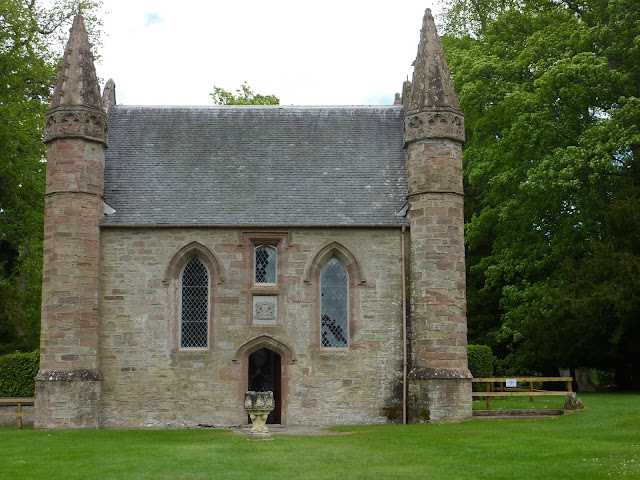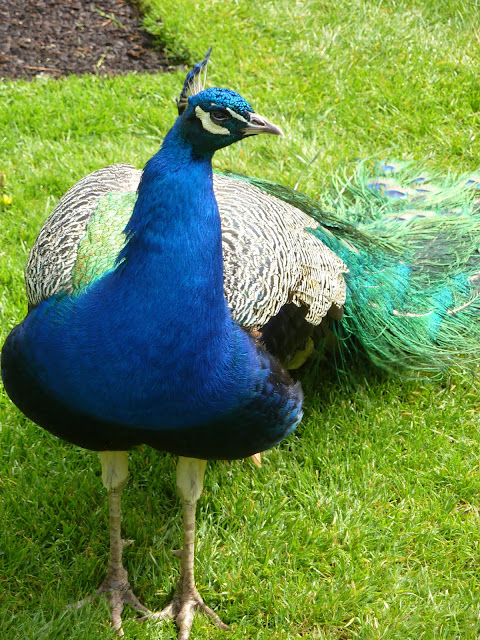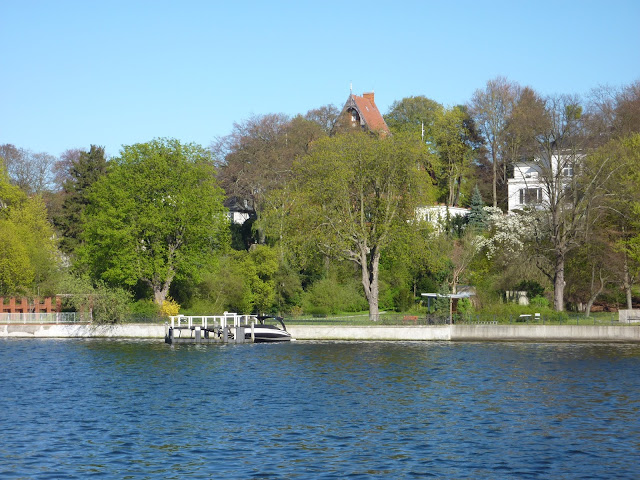The first time we visited Berlin was in August 2012 on an
organised trip and we liked the city so much that we wanted to return under our
own steam, hence this second visit. But before I start to describe this trip I
must make it very clear that our visit was greatly improved by the presence of our
friend’s Tony Barbour and Berlin resident Ulli Myska both of whom acted as our
guide to the German capital and without whose help we would not have had such
an interesting and informative trip. I
can honestly recommend the hotel that we stopped in.
 |
| A Berlin Bear doing a handstand outside the Hotel. |
 |
| A U-Bahn Station that became very familiar. |
It was part of the Adina
Group and was situated very close to the Spittlemark U-Bahn Station at
Krausenstrasse and had a swimming pool and gym in the basement.
Day 1.
 |
| Berlin has a great selection of transport including trams. |
Arrived at Schonefeld Airport to be met by our friends and
taken to our hotel via a weekly transport ticket that allowed us to use of the
BVG Transport System, which includes the U-Bahn, Tram’s, buses and some ferry
networks also the S-Bahn urban railway system, incidentally very good value if
used regularly.
 |
| Lenin-Engels Monument. |
After a short tour that
took in the Lenin-Engels
monument situated on the edge of a public park in Spandauer Str, some lunch in
a typical Berlin restaurant and a look around the Gendarmenmarkt to see both
the German and French Churches and the Schiller Monument.
 |
| Schiller Monument with the French Church behind. |
 |
| A Chocolate Section of the Berlin Wall. |
Then an expensive
treat, a visit to the largest chocolatier in the world where you are faced with
the finest selection of Fassbender and Rausch mouth watering chocolate products
to have with your coffee.
Day 2.
 |
| Ministry for State Security Offices |
One of the places we had planed to visit on this trip was
the headquarters of the GDR Ministry for State Security (MfS) that from 1960/61
until 1989 was one of the most secure area’s in East Berlin. Haus 1 is open to
the public and houses a permanent exhibition showing the workings of the Stasi,
as the people of the Democratic Republic called the MfS, the shield and sword
of the Socialist Unity Party of Germany (SED).
 |
| The Shield and Sword of Socialist Unity. |
As well as being a museum it is
now a research and memorial centre concerning the political system of the
former East Germany. Founded by civil rights activists in 1990 its aims are to
foster the development of the museum as a "centre for the collection,
preservation, documentation, rehabilitation and exhibition of evidence and
research materials relating to East Germany”.
 |
| Erich Mielki rest area. |
 |
| Offices and meeting areas. |
The exhibition is on three floors
of the building and its centrepiece are the offices and working quarters of
Erich Mielke who served as Minister for State Security from 1957 until the
destruction of the Berlin wall.
 |
| Listening devices hidden inside door. |
 |
| A vehicle for transporting and disorientating people used by the MfS |
Other
interesting parts of the exhibition show how the Stasi kept an eye on its
peoples and the tools of its trade including special cameras, bugging
equipment, tools used to enter people’s homes and the devices for clandestine
opening of letters. We also get to find out how many people worked for the
organisation. Approximately 275000 people were employed and a further 180000
East German citizens became IM’s, unofficial informants. I think the main thing
that came out of this very informative exhibition was how well the MfS had
things under control and how much information they had on the citizens of East Berlin.
 |
| East Berlin's World Clock Alexandra Platz. |
Travelling back to our hotel via Saturn at
Alexanderplatz I did find some DAFA DVD’s with English undertitles, more of
which at a later date in my
Movie
Blog.
Day 3.
 |
| Fassbinder. |
One of the things we did not manage time for on our last
trip to this great city was a visit to the German Museum of Film and Television
at Potsdamer Platz, which by the way has greatly enlarged its shop which stocks
a great many film related items including books and DVD’s. The museum is one of
six film museums in Germany and houses exhibits from the entire span of German
film and TV history including the exile of many artists to Hollywood during the
National Socialist era. For 7euro you get to see posters, photos, film
costumes, architectural sketches and props. The highlight for me were the use
of mirrors in certain areas and the sections on Marlene Dietrich, my favourite
German New Wave director
Rainer
Werner Fassbinder and the inventive Leni Riefenstahi who directed and
produced
Olympia (1938) documenting
the 1936 Olympics held in the Olympic Stadium in Berlin, clips of which were
being shown while we were their.
 |
| Brilliant use of mirrors at the Berlin Film museum. |
Being with someone that knows what goes on in Berlin allowed
us to attend a free lunch time concert in the Berlin Philharmonie. These
concerts take place in the very large lobby area of the concert hall, famed for
its acoustics and architecture that is home to the Berlin Philharmonic
Orchestra.
 |
| Patiently waiting for our young performers. |
 |
| The concert hall gradually fills up. |
The concert consisted of four
pieces of classical music from Haydn, Schtschedrin, Paul Hindemith and my own
favourite from Edward Elgar. Young award-winning musicians performed the music;
the youngest was only 12 years old. All were students of the Julius Stern
Institute at Berlin’s University of the Arts. It was a good job we got there
early, as these concerts prove very popular and was packed. Be warned though
you have to sit on the floor or for a better view one of the carpeted staircases
leading up to the first floor, still it was well worth a little discomfort.
 |
| Young performers from the age of Twelve. |
Early evening was spent in one of Hackescher Markt
independent Kino’s (movie theatre) to watch a German film, which fortunately
had English undertitles. The movie was the excellent
Wild
(2016), which for those of you that are interested please click on the link to
sample my review.
Day 4.
Another must visit earmarked for this trip was the Stasi
prison at Berlin-Hohenschonhausen. Following unification of the West and East
German states the prison was closed in October 1990. Former prisoners spoke out
in establishing a Gedenkstatte (memorial) at the site. In 1992 the prison
complex, including the hospital block was listed as a historical monument.
Since 2000 it has been deemed an independent foundation under public law.
 |
| The new prison block.... |
 |
| ....and the hospital block. |
Set up originally as a Soviet internment camp at the end of
World War 2 it became the Stasi detention centre in March 1951 and extended in
the late 1950’s. The new building included an extra 200 prison cells and interrogation
rooms. The hospital wing, run by Dr Herbert Vogel, was extended in 1972. After
the construction of the Berlin Wall in 1961, the prison was primarily used to
house those who wished or attempted to leave the GDR, although political
prisoners were also held there. Any one sentenced to a prison term rather than
detention was placed in one of 16 prisons spread around East Berlin and East
Germany. The prison was used until the Berlin Wall was demolished in 1989 when
a great many of the records were destroyed. Because of this, today's knowledge
of the functioning of the prison complex comes mainly from eyewitness accounts
from ex-prisoners some of whom work at the Memorial as tour guides.
Originally part of an extensive secret area
that no ordinary citizen of the GDR was allowed to enter, an area not shown on
any map, was officially closed on 3
rd October 1990.
 |
| The Submarine.... |
 |
| ....with its very basic facilities. |
 |
| The sensory cell where your confined in the dark. |
Our English speaking tour took in the bunker like cells in
the basement known as the U-Boot or submarine including the rubber walled
sensory chambers. Cells on the floors above bear a resemblance to present day
prison cells including modern sanitary arrangements to comply with prisoner’s
human rights. Also you get to try out the outdoor exercise cells known as
‘tiger cages’ by the prisoners which are not much bigger than the actual cells.
After the tour you can catch the permanent exhibition showing the history of
both the Stasi and the GDR that is well worth a visit – but allow plenty of
time lots to see.
Returning to Hackescher Markt by public transport to have a
meal at the charming Sophien 11 a genuine traditional Berlin pub located in one
of the oldest streets in Berlin, which has a menu that specialises in some real old Berlin
cuisine.
 |
| Sophien famous for its old Berlin cuisine. |
From there it’s only a short distance to see some brilliant
Berlin street art in one of the courtyards leading off Rosenthaler Str.
 |
| Berlin street art. |
The Babelsberg Film Studio is located in Potsdam-Babelsberg
just outside Berlin and is the oldest large-scale film studio in the world ,
one which has been producing films since 1912. Today it covers 25000 square
metres making it Europe’s largest film studios. Early films include Fritz
Lang’s
Metropolis (1927) and Josef
von Sternberg’s
The Blue Angel
(1930), which starred Germany’s most famous actress Marlene Dietrich. More
recent productions include
Bridge
of Spies (2015),
The
Grand Budapest Hotel (2014),
The
Book Thief (2013),
Inglourious
Basterds (2009) as well as the last two Hunger Games movies.
 |
| The studio were The Blue Angel was made, |
The main tourist area is a movie theme park and includes various
attractions including the Dome of Babelsberg in which you sit in a large chair
and get thrown about whilst a 3D cartoon version of Pirates of the Caribbean is
played out on the screen and you get to kill as many ‘objects’ as you can with
a gun attached to the side of your seat! Much nicer is a demonstration of ‘Film
Animals in front of the Camera’ where an animal trainer puts a pig, a dog, a
chicken and a wee pony through their paces.
 |
| "Film Animals" |
The most exciting attraction is the
stunt show in the 2500 seat volcano area. Babelsberg’s stunt men and women put
on a show on a Mad Max type set. Hopefully you will be able to see highlights on
my YouTube Channel (
follow link).
 |
| A cracking stunt demonstration on a Mad Max type set. |
The central part of our visit consisted of the ‘Media City
Tour which included a look at the filming of one of Germanys longest running
soap operas
GZSZ (Good Times, Bad
Times) which was first shown in 1992 when it was panned by the critics but has
since risen to the heights of popularity.
Based on the Australian format of
The
Restless Years it concerns the lives of a fictional neighbourhood in Berlin
and deliberately targets a young viewership. We were also shown two film sets
that had been set up at the studio. The first was one of my favourite movies
The
Baader Meinhof Complex (2008) a film about the Red Army faction between
1967 and 1977. The second set was for
The
Monuments Men (2014), which was directed by and starred George
Clooney.
 |
| Props from Der Baader Meinhof Complex. |
 |
| Relocated set from Monuments Men. |
From Potsdam we travelled back to Wannsee, a suburb of
Berlin famous for the conference in 1942 to discuss the implementation of the
final solution to the Jewish question whereby most of the Jews of German
occupied Europe would be deported to prison camps in Poland, and then a ferry
across the River Havel to Kladow on the other side.
 |
| Ferry across the Havel. |
After a long day we
travelled by bus to Spandau to the wonderful Fisch Frank restaurant in Charlottenstraße
7, it may be small but it has a justifiably good reputation.
 |
| Tasty fish dish at the Fisch Frank. |
Day 6.
After walking to Checkpoint Charlie for coffee it was a
shopping day, starting at Potsdamer Platz and then walking through the
Tiergarten to Brandenburg Gate and catching a 100-tourist bus to shop at
Alexandra Platz.
Day7.
Deemed an institution by Berlin residents the Winterfeldt
Markt near Nollendorfplatz station proved to be well worth a visit on a
Saturday morning by all four of us. The
leafy square surrounding the St Matthias Kirk has approximately 250 stalls
mainly selling seasonal fresh farm or market garden produce but also you can
find some rare ingredients like wild herbs, edible flowers, foraged mushrooms
and locally made salamis along side some mouth watering cooked food.
 |
| Winterfeldt Market on a busy Saturday morning. |
Next stop was The KaDeWe, which is short for The Kaufhaus
des Westerns (Department Store of the West). With 8 floors totalling 60,000
square metres of selling space and more than 380,000 articles available, it is
the largest department store in
Continental Europe. It is alleged that it attracts
40,000 to 50,000 visitors every single day. The highlight is the gourmet food
market floor, where the amount of different food on display has to be seen to
be believed. Even in this age of austerity you can witness large groups of
people digging in to oysters and Champaign!
 |
| The largest store in continental Europe. |
After looking at all this food hunger was beginning to creep
up. The Berliner Funkturm Tower restaurant at 55metres above ground level was
the next stop. The former Berlin Radio Tower, now a protected monument, was
constructed between 1924 and 1926 and originally planned as a transmitting
tower but now has not only the restaurant but an observation deck at 126metres
above ground level reached by a lift that travels up to 6 metres a second. Both
the food and the towers top deck make the tower well worth a visit, the views of
Berlin from the top are breath-taking (
see
link).
 |
| The former Berlin Radio Tower. |
 |
| The restaurant 55 metres above ground level. |
 |
| Across to the TV Tower in Alexandra Platz. |
 |
| The Olympic Stadium home to Hertha Berlin. |
After a quick look at the book shop that formed part of the
Helmut Newton exhibition we travelled back to Alexandra Platz on the top deck
of the 100-tourist bus allowing us to take in even more views of a city that’s
constantly full of surprises.
 |
| Various views fro the 100-bus. |
Day 8.
On our final full day we travelled to Podbielskiallee for Sunday
brunch at Eierscale (Eggshell) Dahlem with our wonderful friends who as I said
before have really made this holiday special. This traditional restaurant is on
two floors with a spacious outdoor area and on a Sunday is full of local Berlin
families enjoying a very well laid out buffet and live music. Not only famous for its cuisine but also its
visual appeal with its beautiful wall paintings, gilded stucco ceilings, and a
magnificent chandelier that spans both floors.
After leaving the Eierscale we had a tour of the local area
including a walk in a woodland area our first real countryside walk since
arriving in Berlin. Then on to enjoy coffee at a restaurant in the uniquely
named Mexikoplatz, a suburban area in
the far southwest corner of Berlin.
 |
| The idilic Mexikoplatz. |
The main event of the day was a Jazz Concert at the rather
plush Rathaus (Town Hall) in Kleinmachnow. Titled
Swingin’ Ladies Plus 2 this extremely talented quartet consisted of
Nicki Parrott, who originated in Australia, on bass and vocals, the very
talented St Louis Missouri born 29 year old stride, ragtime and jazz pianist
Stephanie Trick who along with her Italian husband Paolo Alderighi was on piano and Germany’s
own Engelbert Wrobel on sax and clarinet who also took on the role of master of
ceremonies. Most of the material was taken from the quartets CD
From Joplin to Jobim released in January
2016 and consisted of some great jazz instrumentals, wonderfully appealing
vocals from Ms Parrott and some great 4 handed piano pieces from the husband
and wife duo. The hall was packed with a very appreciative German audience and
the performers were happy to chat to their audience and have photos taken at
the mid way break. It certainly rounded off a delightful holiday.
 |
| Stephanie Trick. |
 |
| Stephanie Trick with husband Paolo Alderighi. |
 |
| The multi talented Nicki Parrott..... |
 |
| ....with Engelbert Wrobel. |
 |
| The final bow. |


































































































































